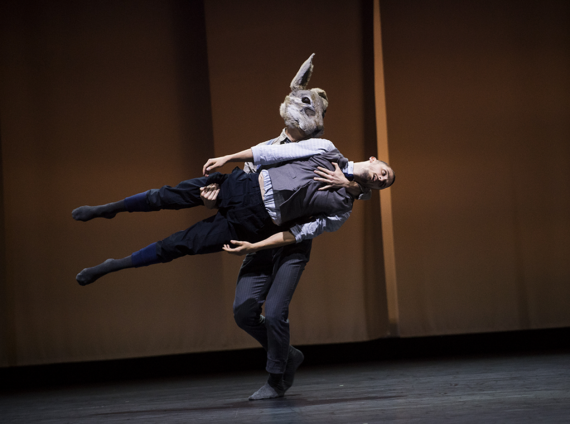
Pontus Lidberg's "Rabbit," photo by Tristram Kenton
In recent years, Michael Nunn and William Trevitt's BalletBoyz have attracted top choreographic talent, and it's easy to see why. Boasting ten accomplished, eager and distinctive male dancers, the company itself provides rich creative stock.
Still, the troupe's collective power and virility sometimes proves to be as much of a liability as an asset. As their latest production Life shows, there is a fine line between finding artistic inspiration in these qualities -- and really, who wouldn't? -- and using them as a substitute.
This was one of the unintended contrasts that found its way into an evening that was all about dichotomies. Featuring new works by Swedish choreographer and film-maker Pontus Lidberg and veteran Venezuelan dance-maker Javier de Frutos, Life is a tribute to the tensions between life and death, the real and the imagined, the heartbreaking and the absurd.
Lidberg's "Rabbit" opens the program in a surreal dreamscape. A solitary swing hangs against a twilight-hued backdrop. Two men perform a melancholy duet to the mournful strains of Henryk Górecki's Little Requiem for a Classic Polka. One of them wears a lifelike rabbit mask.
More dancers join -- some men, some rabbits, some a little of both. The way they tumble on and off stage beneath the panel-draped wings makes it seem as if they are slipping under a closed door, appearing and vanishing in a space heavy with subconscious symbolism. The world Lidberg has created is a private, inner one.
But our inner worlds have their lighter moments, and so does Lidberg's creation. Between introspective solos and aching duets, riled-up rabbits chug, skip and jig. Reflecting the progression of the music, "Rabbit" is by turns contemplative, manic and just plain funny.
Lidberg's choreography favors high-contact partnering and low, grounded movements that expand into melting, sinuous lines. It is physically demanding, but never showy, and structurally and musically sophisticated. The style works beautifully on the BalletBoyz: refreshingly, it puts their physical prowess to the service of their considerable artistic gifts. Restraint is a good look for them.
But it doesn't last long. In the second half, "Fiction" constructs a living wake around de Frutos' own, imagined death. Fittingly for the flamboyant choreographer, restraint is out the window.
The work is set in the BalletBoyz studio as they warm up to rehearse. News of the choreographer's death -- by a falling shard of plastic, we're told -- sends them into a tailspin of grief. As a recorded obituary recounts the highs, lows and many controversies of de Frutos' career -- including one work described by a critic as the "greatest piece of crap ever made" -- the dancers struggle to move on, each grieving in his own way.
Anchoring the piece is a steel ballet barre that the young men slide under, jump over and cling to for dear life for most of the piece. As a pillar of stability and the foundation of ballet class, the barre is an effective symbol, and at times, it enables some interesting choreography.
But the barre becomes a crutch, the beefcake acrobatics get stale, and the tongue-in-cheek humor of the obituary quickly gives way to self-indulgence. When a lone dancer shakes off his grief disco-style to Donna Summers' "Last Dance" in the final frame, the audience-rousing effect feels eye-rollingly manufactured.
Still, the bold contrast between the two choreographers in Life speaks to the artistic ambitions of Nunn and Trevitt, as well as the creative hunger of their dancers. As the company continues to mature beyond its origins as a talent showcase, hopefully they'll learn to trust that less is often more.
Our 2024 Coverage Needs You
It's Another Trump-Biden Showdown — And We Need Your Help
The Future Of Democracy Is At Stake
Our 2024 Coverage Needs You
Your Loyalty Means The World To Us
As Americans head to the polls in 2024, the very future of our country is at stake. At HuffPost, we believe that a free press is critical to creating well-informed voters. That's why our journalism is free for everyone, even though other newsrooms retreat behind expensive paywalls.
Our journalists will continue to cover the twists and turns during this historic presidential election. With your help, we'll bring you hard-hitting investigations, well-researched analysis and timely takes you can't find elsewhere. Reporting in this current political climate is a responsibility we do not take lightly, and we thank you for your support.
Contribute as little as $2 to keep our news free for all.
Can't afford to donate? Support HuffPost by creating a free account and log in while you read.
The 2024 election is heating up, and women's rights, health care, voting rights, and the very future of democracy are all at stake. Donald Trump will face Joe Biden in the most consequential vote of our time. And HuffPost will be there, covering every twist and turn. America's future hangs in the balance. Would you consider contributing to support our journalism and keep it free for all during this critical season?
HuffPost believes news should be accessible to everyone, regardless of their ability to pay for it. We rely on readers like you to help fund our work. Any contribution you can make — even as little as $2 — goes directly toward supporting the impactful journalism that we will continue to produce this year. Thank you for being part of our story.
Can't afford to donate? Support HuffPost by creating a free account and log in while you read.
It's official: Donald Trump will face Joe Biden this fall in the presidential election. As we face the most consequential presidential election of our time, HuffPost is committed to bringing you up-to-date, accurate news about the 2024 race. While other outlets have retreated behind paywalls, you can trust our news will stay free.
But we can't do it without your help. Reader funding is one of the key ways we support our newsroom. Would you consider making a donation to help fund our news during this critical time? Your contributions are vital to supporting a free press.
Contribute as little as $2 to keep our journalism free and accessible to all.
Can't afford to donate? Support HuffPost by creating a free account and log in while you read.
As Americans head to the polls in 2024, the very future of our country is at stake. At HuffPost, we believe that a free press is critical to creating well-informed voters. That's why our journalism is free for everyone, even though other newsrooms retreat behind expensive paywalls.
Our journalists will continue to cover the twists and turns during this historic presidential election. With your help, we'll bring you hard-hitting investigations, well-researched analysis and timely takes you can't find elsewhere. Reporting in this current political climate is a responsibility we do not take lightly, and we thank you for your support.
Contribute as little as $2 to keep our news free for all.
Can't afford to donate? Support HuffPost by creating a free account and log in while you read.
Dear HuffPost Reader
Thank you for your past contribution to HuffPost. We are sincerely grateful for readers like you who help us ensure that we can keep our journalism free for everyone.
The stakes are high this year, and our 2024 coverage could use continued support. Would you consider becoming a regular HuffPost contributor?
Dear HuffPost Reader
Thank you for your past contribution to HuffPost. We are sincerely grateful for readers like you who help us ensure that we can keep our journalism free for everyone.
The stakes are high this year, and our 2024 coverage could use continued support. If circumstances have changed since you last contributed, we hope you'll consider contributing to HuffPost once more.
Already contributed? Log in to hide these messages.

